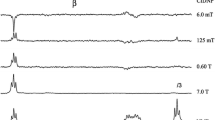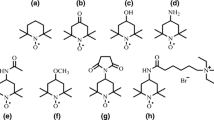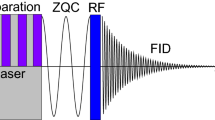Abstract.
In the frozen state, dynamic nuclear polarization (DNP) can enhance the nuclear magnetic resonance (NMR) signal by different mechanisms, broadly described as solid effect or thermal mixing. The dominant mechanism has been previously investigated by monitoring the level of polarization at discrete frequencies across the line width of the electron paramagnetic resonance: a microwave sweep. Results suggest that for DNP using trityl radical at 1.4 K and 3.35 T, thermal mixing dominates the polarization for 13C and 15N. A high-sensitivity probe that can be inserted into a Hyper-Sense DNP polarizer has been designed to observe the solid-state NMR signal over the X-band range of nuclei as they are polarizing. We examine the optimum polarization frequencies for 13C, 2H, 29Si, 15N and 31P by means of microwave sweeps and from these infer the polarization mechanism of particular nuclei for the conditions of polarization. We also determine the polarization buildup time constant for some typical compounds in order to provide some indicative polarization times that can be used before the sample is transferred to the liquid state.
Similar content being viewed by others
References
Ardenkjaer-Larsen, J.H., Fridlund, B., Gram, A., Hansson, G., Hansson, L., Lerche, M.H., Servin, R., Thaning, M., Golman, K.: Proc. Natl. Acad. Sci. USA 100, 10158–10163 (2003)
Abragam, A.: Principles of Nuclear Magnetism. Clarendon, Oxford (1983)
Wind, R.A., Duijvestijn, M.J., van der Lugt, C., Manenschijn, A., Vriend, J.: Prog. Nucl. Magn. Reson. Spectrosc. 17, 33–67 (1985)
de Boer, W.: J. Low Temp. Phys. 22, 185–212 (1976)
Atsarkin, V.A.: Sov. Phys. Usp. 21, 725–743 (1978)
Slade, R., Hutton, G., Blazina, D.: Characterising Solid-State DNP. Application Note. Oxford Instruments Molecular Biotools, Tubney Woods, UK (2006) http://www.oxford-instruments.com
Blazina, D., Reynolds, S., Slade, R.: Influence of Trityl Radical on the DNP Process. Application Note. Oxford Instruments Molecular Biotools, Tubney Woods, UK (2006) http://www.oxford-instruments.com
Gabellieri, C., Reynolds, S., Lavie, A., Payne, G.S., Leach, M.O., Eykyn, T.R.: J. Am. Chem. Soc. 130, 4598–4599 (2008)
Wolber, J., Ellner, F., Fridlund, B., Gram, A., Johannesson, H., Hansson, G., Hansson, L.H., Lerche, M.H., Mansson, S., Servin, R., Thaning, M., Golman, K., Ardenkjaer-Larsen, J.H.: Nucl. Instrum. Methods Phys. Res. A 526, 173–181 (2004)
Author information
Authors and Affiliations
Additional information
Authors' address: Steven Reynolds, Oxford Instruments Molecular Biotools, Tubney Woods, Abingdon, OX13 5QX, United Kingdom
Rights and permissions
About this article
Cite this article
Reynolds, S., Patel, H. Monitoring the Solid-State Polarization of 13C, 15N, 2H, 29Si and 31P. Appl Magn Reson 34, 495–508 (2008). https://doi.org/10.1007/s00723-008-0117-5
Received:
Issue Date:
DOI: https://doi.org/10.1007/s00723-008-0117-5




